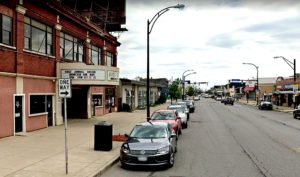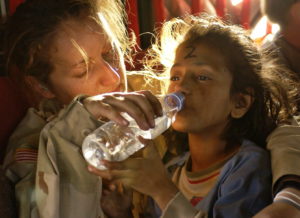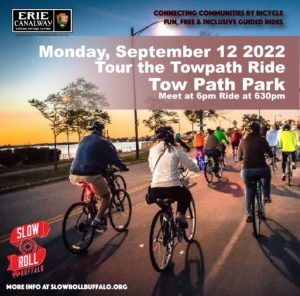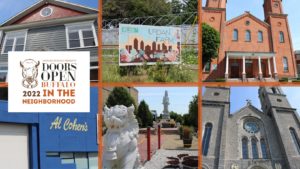This is the final piece of the “Off Broadway” article that was posted during the pandemic. These are the memories of Alex Ramsey, who grew up on the city’s East Side. It is interesting to note that he has been living in Texas since 1977, but that his fondest memories are from his youth. Alex was born in 1956.
“The cohesiveness of the neighborhood itself made it a truly special time and place to grow up in.”
My final installment on growing up and finally leaving Buffalo.
It was mid January 1977, and was totally clueless as to what I was flying into. I left Dallas/Ft.Worth Airport with a small bag, wearing shorts and a t-shirt, (it was 65 degrees in DFW). A simple 2-1/2 hour flight into Chicago, then a quick 50 minute flight into Buffalo e.t.a.11:00 am, having left my apartment @ 7:00 am.
While en route, the pilot came on several times broadcasting cautionary updates regarding the weather in Chicago. Around 2 hours in, he announced Chicago’s midway and O’Hare were closed due to ongoing snow squalls there, so we were diverting to Dulles in Washington D.C. I thought, hmmm…I arranged with Phil Cupples at Southwire (the man that hired me – last episode), to begin working in 7 or 8 days.
I thought, maybe stay a couple days in D.C.to see the sights there since I’d never been, then fly into Buffalo. Then the pilot comes on – scratch Dulles, it’s also closed. He’d mentioned turning around and flying back to DFW, but scratched that due to being low on fuel. The cities just south of our flight path were closed due to ice conditions, so the pilot forged onward announcing the option was to land in a snow squall rather than ice conditions.
Consequently around 11:00 A.M. we landed in a white-out squall in Syracuse, NY. We had to exit the plane while on the tarmac, since the drifts adjoining the building terminals were 10 ‘-12’ high. People were staring at me in my canvas Converse sneakers, in shorts, wearing my I Love Buffalo t-shirt. No jacket, nor sweater. The airport was closed indefinitely, as was the I90, so car rental or a greyhound was out.
Fortunately I grabbed a cab that took me to the Syracuse train station! No force other than Jesse James can stop a train, I thought. There was an outgoing train leaving for Chicago via Buffalo at 6:00 pm., with the eta to Buffalo arriving at 10:00 pm. The 6 hours in an old-creaky Syracuse train station was beating. There were about 10 or 12 of us crashed out on the benches that resembled Catholic Church pews. At least the coffee vending machine was working, as were the sandwich machines, and the heating system in the terminal.
Finally after 7 arduous hours, we boarded @ 7:00 pm. I felt so nasty and grubby, craving a hot shower. At least the train seats were comfortable, We were furnished with small blankets and a pillow – a major upgrade from wooden pew sleeping.
The conductor gave us frequent updates as to the grudgingly slow train ride heading west, into the eye of the storm (thank you Lake Erie!). After a torturous 12 hours, we crawl into Central Terminal at 6:00 am. The conductor announces that for the FIRST time since 1832, the trains will stop rolling in Buffalo (in or out), for they railroads had no way of clearing the tracks to allow passage. He wished us all luck – those that live in Buffalo. He warned us to be careful out there – essentially Martial Law was enacted, threatening anyone even trying to drive a car that was unauthorized. Only FIRST responder-related vehicles – Police, Fire, EMT’s, etc. – violators were subject to arrest, with vehicle impoundment and a $500 (1977 dollars) fine!
The old Central Terminal building is essentially nestled in a triangle of three streets. Paderewski Drive, running east to west, dead-ended into the building’s parking lot to the east. Memorial Drive and Curtiss Street form a V. Curtiss ran south into the building, and north into Broadway. Memorial Drive ran northeast from William Street and Fillmore Avenue, also into Broadway. Neither of those streets were plowed until you got to Broadway, which was a designated “Snow Emergency Street.” It was continuously plowed for emergency vehicle access.
The snow on Curtiss (the more direct path to Broadway), was – depending on the drifts – literally 4′-6′ high. The snow was still falling from the sky, blowing in west to east (I later learned, right off the lake). Temperature was around 10 degrees, gale force winds (I later heard from 40-60 mph). I had to trudge home on Broadway carrying my suitcase and wearing shorts, t-shirt, and sneakers. I could stay in the Central Terminal, but again on pews, and to what end?
So off I went, literally throwing the suitcase as far as I could. Then had to crawl on top of the drifts that were up to my armpits at the lowest point, and over my head (I’m 6’1″). On soft topped drifts, I’d literally sink into the snow. I had to burrow upwards. My body was literally parallel to the ground most of that arduous journey to Broadway. Even though I was shivering, I was perspiring heavily, soaking my shorts and t-shirt, which made it feel exponentially colder.
The distance from the Central Terminal building where I exited onto Curtiss to Broadway is between 1/4-1/2 mile or so… on a dry sidewalk, an 8-10 minute stroll. I exited the building at 6:00 am, and on my final toss of the suitcase, I heard it hit the ground… Mazel tov! I was burrowing onward with 2-3 feet of snow above me. Freezing and shivering as I was, it actually felt warmer while burrowing because there’s no wind down there. Final burrow and my head popped out – I could see the pavement of Broadway, with snow, still falling, downward and sideways, wind howling. The time was 7:15 am. 1 hour and 15 minutes of trudging and burrowing. As miserable, cold, and exhausted as I was, it felt good to be upright, with my feet actually touching the ground.
18 years later, I’d be running in the Dallas White Rock Marathon. Blue skies, icy streets, and 16 degrees when I started the run. 4 hours later when I finished, it was 26 degrees. I was cold and tired that day when I finished, but it was a cakewalk compared to the ordeal on Curtiss Street!
I was hoping that my landlord Pete had come through the day, as he always did in past snowstorms – and he did. The one type of establishment that never closes in Buffalo – at least then – are the bars! I think the old “Blue Laws” in effect back then in Buffalo, blocked bars from opening till noon on Sundays, but otherwise, most of Buffalo’s “Gin Mills” were open everyday 7:00 am to 4:00 am. Sure enough, Pete who owned a snowplow, kept a 2 foot wide path plowed down from Broadway, up to his front door of the bar. The bar was open for business already at 7:20 am, with 4 or 5 of “The regulars” at the bar drinking beer and downing shots.
Pete was astonished at the sight of me, asking where I was and why? I was a freezing, shivering, ragged mess, but the gas heated old building felt so good. Pete unlocked the back interior door that led to the stairs to both of our flats, (the drifts adjacent to the building were 6′-8′ high). The door that I would normally access to get to the staircase off of Rommel is at least 7′ high (the top half all glass) was totally covered by drifted snow. I couldn’t see out!
The airport, if I recall, remained shut down for 8 or 9 days. I contacted Phil Cupples, explaining my being “trapped” in Buffalo. Being the swell guy he was, told me Buffalo was in the headlines in Texas, and that he’d hold the job open for me till I could make it out of there.
My parents couldn’t believe my 24-hour ordeal. Never has a hot bath ever felt so damned good as it did that day. It was 8 or 9 days till the airport opened back. The driving ban was still on, so with my converse sneakers, long pants/dungarees (I’m glad I didn’t take all my clothes to Texas with me!), gloves, a borrowed coat from my Dad, and a beanie, carrying my suitcase… I again parted company with my beloved parents to start walking to Buffalo’s airport. The 8 or 10 miles.
Fortunately I walked maybe 2 or 3 of those miles, before – graciously – a volunteer firemen (one on a snowmobile) saw me with the suitcase. He would drive me as far as he could, as they were delivering medicines, insulin, and hot food mainly to the elderly, etc.
I got on the plane, and we took off. We flew over downtown and Lake Erie. Only rooftops were visible from high up – a sea of white below me, virtually no movement. The skies were that purplish tone of blue. That day, the winds had died down, with temperature in the teens.
I waved goodbye to the city of my birth – the Queen City, Buffalo, New York – forever (other than numerous visits over the years). I settled in Arlington – living in the same house that I bought the next year, for 36 years. I worked that forklift job at Southwire for a couple months, hooked up with GM, also for a couple months, and after submitting applications to several Police Departments, was recruited by 3 in 1 week! DFW Airport Police, Grand Prairie PD, and Arlington PD.
For several reasons I opted for Arlington. I told the recruiting Sgt. “Booger Red” Martin (never did ask him how he got that name – didn’t want to know) of my experiences with law enforcement agencies in Buffalo. He said to me, “You’re in Texas now boy, we don’t play them Yankee games here – we hire qualified officers.” Hmm I thought, what a novel idea.
I spent 28-1/2 years with Arlington PD, retired to start up a new law enforcement career with the Tarrant County Sheriff’s office in downtown Ft. Worth for 8 more years, and retired with 2 pensions at the age of 57 – having been an officer and deputy for 36 years, 7 months, and 22 days.
I sold my home in Arlington and moved to Austin, TX., retiring to a whole new career – full-time grandpa for my beloved twin grandsons, 4 days a week, 9-10 hours a day, beginning when they were 7 months old,
These days – part-time with my little guys, soon to turn 9 years old – I still make the short drive to my daughter and son-in-law’s home, make my ’em grandpa breakfasts from scratch – no cold cereal or microwave stuff, take ’em to school, pick ’em when needed, sleepovers at G’pa’s every few weeks.
I’ve never mentally adopted Austin as I did Arlington, but to this day, whenever – especially Texans – hear me say youse guys instead of y’all, or peeecan instead of pikaann, I automatically explain, Buffalo, New York……Go Bills!
“Off Broadway” Part VII
Off Broadway” Part VI
“Off Broadway” Part V
“Off Broadway” Part IV
“Off Broadway” Part III
“Off Broadway” Part II
“Off Broadway” Part I
Lead image: Wikipedia
The post “Off Broadway” Part VIII appeared first on Buffalo Rising.









